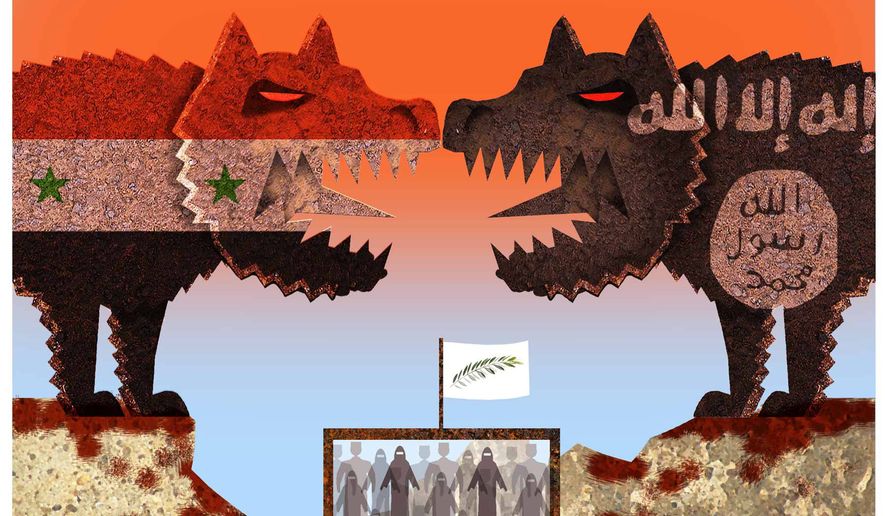OPINION:
The situation in Syria remains bleak, with no end in sight to its five-year civil war. President Bashar Assad’s forces and their Russian and Iranian backers continue to lay waste to rebel-held territory, leaving the rebels with shrinking leverage to pressure the regime into a lasting political settlement. Meanwhile, the Islamic State (ISIS) holds key territory along the Euphrates River and threatens rebel positions at the Turkish border.
Negotiations have been unable to secure a cease-fire long enough to allow any progress toward a diplomatic solution, and the Obama administration has given no indication that it has a Plan B. The Assad regime’s strategy is now clear: to avoid compromise and indiscriminately bomb its way to victory.
But as we head toward elections in November, U.S. policy in Syria is again a topic of national conversation. Fifty State Department officers recently expressed frustration with the current Syria policy and emphasized the need for a more militarily assertive role by the United States to help end the bloodshed and compel the regime to continue diplomatic efforts. With the Islamic State threatening the homeland, with the conflict claiming more than 400,000 dead and 4.9 million refugees, and with many of those refugees now placing great strain on Europe, the war is clearly a threat to international security. We have little choice but to return to the question of safe zones for Syria.
Though often used interchangeably, “safe zones” and “no-fly zones” actually represent different levels of commitment. Generally, a no-fly zone prevents hostile action from the air only, while a safe zone implies an area secure from both airborne and ground attack that often requires the commitment of air and ground forces. The more recent U.S. experience in Libya demonstrated that we don’t necessarily have to choose one; American-led forces targeted pro-government forces in the air, land and sea without the use of ground forces. Of course, the U.S.-led operation in Libya in 2011 was no great success. The mission succeeded in its goal of preventing an impending humanitarian disaster and accelerated the fall of Moammar Gadhafi. However, the United States made some of the same mistakes it made in Iraq in 2003 by destroying the local authority without a plan to replace it. Libya is now steeped in chaos.
In Syria, an American-led effort does not have to go the way of Libya. It would not have to focus on immediate regime change, but rather on mitigating the spiraling death toll, providing a safe space for moderate opposition to form governing structures and rebuild civil society, and allow for the introduction of humanitarian assistance. If properly enforced, refugees could resettle in these protected areas and begin the process of building an alternative to Mr. Assad, which can be leveraged in future negotiations to end the conflict.
Still, there are several legitimate concerns regarding the viability of establishing safe zones. For example, Russia has been operating in Syria since September 2015 — ostensibly to fight ISIS, but in reality it is bombing opposition groups, including those fighting ISIS, to ensure the survival of the Assad regime. Turkey’s November 2015 downing of a Russian Su-24 jet demonstrated the volatility of the situation, and a recent report suggests that Russian and American jets nearly clashed in Syrian skies over the weekend. Thus, deconflicting with Russia will remain a huge challenge.
There is no dearth of literature out there expressing concern that safe zones might not actually be safe for civilians. Experts cite the 1995 massacre of more than 8,000 Muslim Bosniaks in Srebrenica — after NATO had established a safe zone — as an example of what could go wrong if not properly enforced. Similarly, analysts cite the initial no-fly zone established against Saddam Hussein following the Gulf War of 1991 as an example of an ill-defined and poorly executed endeavor. The cease-fire agreement prohibited the Iraqi military from flying fixed-wing aircraft, but permitted the use of helicopters, which it used to crush postwar uprisings by Kurds in the north and Shiites in the south (the no-fly zones later included helicopters after more than 100,000 were killed).
These precedents certainly suggest that declaring a safe zone without providing adequate protection might be worse for returning civilians if Western nations are reluctant to commit ground forces to protecting the defined area. In the case of Syria, there is the additional concern of whether rebel groups would be able to enter these zones, with extremist opposition forces like Jabhat al-Nusra often working closely with more purportedly moderate groups.
Any discussion of establishing safe zones must address these concerns. But with a political solution in Syria remaining elusive, a military component to the campaign may now be unavoidable. And it cannot be only focused on defeating the Islamic State. Syria needs a comprehensive approach that includes re-establishing governance and civil society in recaptured territory.
Establishing safe zones will not be easy. Forming a broad coalition and then implementing safe zones will be neither quick nor cheap. However, only when there is some semblance of stability will Syrians see there is another option to the violent civil war that has devastated their country, and an alternative to the tyranny of Mr. Assad and the ruthlessness of ISIS. And as we have seen in recent Islamic State attacks at home and abroad, their stability has an impact on ours.
• John Cappello is a senior fellow at the Foundation for Defense of Democracies and a former U.S. Air Force B-1B pilot. Patrick Megahan is a research analyst at the Foundation for Defense of Democracies.




Please read our comment policy before commenting.